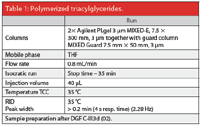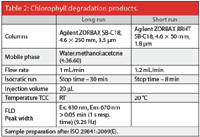Thermal Treatment Analysis — Determination of Polymerized Triglycerides and Chlorophyll Degradation Products
Agilent Technologies
The presence of polymerized triacylglycerides or chlorophyll degradation products in olive oil indicates that the oil has been refined or subject to other thermal treatment processes. In this study, several olive oils were analyzed using the Agilent 1260 Infinity LC with refractive index and fluorescence detection.
Virgin olive oil can be created only by mild, cold pressing of olives (Olea europea L.). In addition to the determination of stigmastadienes (1), the quantification of polymerized triacylglycerides and chlorophyll degradation products in olive oil is another important factor to determine whether thermal treatment was used.

Table 1: Polymerized triacylglycerides.
During different refining steps, the oil components are chemically altered (2). Polymerized triacylglycerides are normally not present in crude vegetable oils. During the extraction processes, the chlorophyll a and b pigments are converted into the more stable pheophytins (3), which in turn undergoes slow decarboxymethylation to give pyropheophytin.

Table 2: Chlorophyll degradation products.
Experimental Conditions
Results
In contrast to virgin olive oil, the partly refined olive oil chromatogram showed dimerized triacylglycerides (Figure 1a). In addition, a higher percentage of chlorophyll a degradation products are found in partly refined olive oils (Figure 1b).

Figure 1: Detection of (a) polymerized triacylglycerides and (b) chlorophyll degradation products in partly refined olive oil.
Conclusion
Only negligible amounts of polymerized triacylglycerides were detected in all six virgin olive oils. In addition, in fresh virgin olive oils, only a minor amount of pyropheophytin was detectable, but as it develops slowly during storage, higher amounts were detected in several longer stored virgin olive oils as well as in the partly refined olive oil.
References
(1) Quality Analysis of Virgin Olive Oils – Part 1, Agilent Application Note, Publication Number 5991-1894EN, 2013.
(2) G Billek, European Journal of Lipid Science and Technology94(5), 161–172 (1992).
(3) K Aitzetmueller, European Journal of Lipid Science and Technology91(3), (1989).

Agilent Technologies Inc.
5301 Stevens Creek Blvd., Santa Clara, California 95051, USA
Tel: (800) 227 9770
Website: www.agilent.com

New Study Reviews Chromatography Methods for Flavonoid Analysis
April 21st 2025Flavonoids are widely used metabolites that carry out various functions in different industries, such as food and cosmetics. Detecting, separating, and quantifying them in fruit species can be a complicated process.
Analytical Challenges in Measuring Migration from Food Contact Materials
November 2nd 2015Food contact materials contain low molecular weight additives and processing aids which can migrate into foods leading to trace levels of contamination. Food safety is ensured through regulations, comprising compositional controls and migration limits, which present a significant analytical challenge to the food industry to ensure compliance and demonstrate due diligence. Of the various analytical approaches, LC-MS/MS has proved to be an essential tool in monitoring migration of target compounds into foods, and more sophisticated approaches such as LC-high resolution MS (Orbitrap) are being increasingly used for untargeted analysis to monitor non-intentionally added substances. This podcast will provide an overview to this area, illustrated with various applications showing current approaches being employed.

.png&w=3840&q=75)

.png&w=3840&q=75)



.png&w=3840&q=75)



.png&w=3840&q=75)







